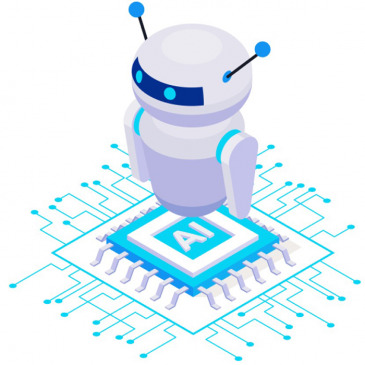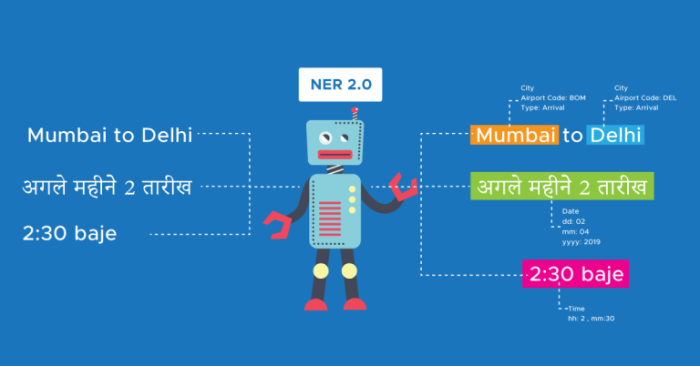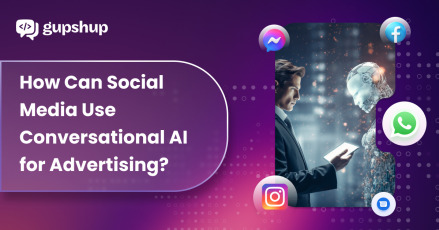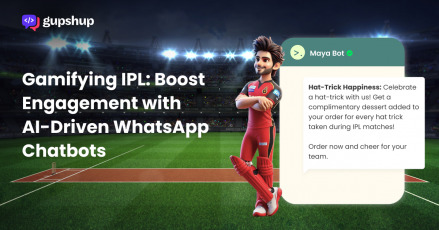Make Automation More Personal with Conversational AI-powered Chatbots

Conversational AI-powered chatbots are just about everywhere these days. When trying to solve a problem, or amend an order, customers want a quick and easy solution that’s readily available. Nowadays, a ticketing system or customer service only available over the phone simply won’t do.
According to one study by HubSpot, ⅔ of customers expect a response to their enquiry within 10 minutes. And not all companies can afford to have a 24/7 customer service team.
This is why chatbots are a useful tool for businesses of all sizes.
Chatbots are perfect for those customers that have a phobia of speaking on the phone, and can also save your customer support team lots of time by answering simple questions without human interference needed. However, it’s important to not only choose the right chatbot service for your business but also ensure it is advanced enough to understand a multitude of queries and answer them in a personable way.
If you’re looking for a way to offer your customers round-the-clock support that’s personal to them, you need an AI-powered chatbot.
Using chatbots for your business: Pain points
In the past, chatbots haven’t been used to their full potential. This means that most businesses have already shunned the idea of implementing chatbot automation. There are several pain points that make bots feel a little unappealing:
- Impersonal The biggest problem with standard chatbots is that they’re simply too robotic. Customers do not feel like they’re being really heard, and the tone of voice is usually quite stagnant. Personalization is so important for the modern consumer, that all elements of the pre and post-sales experience need to feel like it’s been made specifically for them.
- Limited in capabilities Traditional chatbots tend to work with automated, transcribed answer templates. Not only are these pretty impersonal, but they also don’t always fit in with what the customer is actually asking. Old bots pick up on certain keywords and provide an answer that seems to match. This can be hugely infuriating for customers, and they may end up just going around in circles – ultimately leaving with a bad impression of your business.
- Time-consuming to train
In order to make the average chatbot more personal, you’ll need to continuously add new responses and monitor every conversation. This is time-consuming and highly inefficient.
Thankfully, there is a way to solve all these three pain points. And the solution is an conversational AI-powered chatbot.

What is a conversational ai-powered chatbot?
Chatbots have been around for quite some time, but technology has often been limited. A chatbot is similar to a live chat service. However, the major difference is that there’s no human at the end of the line. Instead, customers can chat away and ask questions which will then be answered by a computer. Older generation chatbots can only save names and numbers, or direct customers to articles from your business’s knowledge bank.
AI-powered, conversational chatbots on the other hand can speak to customers using natural language processing. They’re the most advanced type of bots available and are much more capable in identifying what a customer is asking, and how best to help them. And, as AI is a constantly learning technology, the chatbot gets smarter with age. The end result? A human-level interaction for your customers, any time they need it.
But how do you get started?
How to create a personalized experience with conversational AI-powered chatbots
Customers want to feel like they’re getting valuable information for their problems. In an ideal world, a chatbot would be so good that a customer can’t tell the difference between a person and a computer! Despite there being no person-to-person interaction, there are still plenty of ways to make your automated chatbot personal. Because as we now know, personalization can do wonders for your business. In fact, McKinsey found that personalising the customer experience can improve conversion rates by a massive 15%.
Here’s how to do it.
Train your AI chatbot to read between the lines (identify message intent)
Human customer support teams are able to read between the lines of a customer enquiry to find what the customer is really looking for. Conversational AI-powered chatbots need to be able to do the same. Usually, you can train your chatbot to identify certain keywords, to get the technology started with the learning process. The better your chatbot can read message intent, the better support it can offer your customers.
Personal conversation design
When it comes to creating a personalised experience with chatbots, there needs to be a huge focus on how the computer is designed to talk to your customers. Using a conversational tone, rather than automated, scripted responses will certainly help. A customer wants to feel like the chatbot can help with their specific query, rather than offering stock responses for what it thinks the problem is. As you won’t have someone constantly monitoring your chatbot, you need to also make sure that the language it’s using isn’t open to misinterpretation and is easy to understand by any customer. Remove any jargon and make sure the bot is detailed in its responses.
Keep up with the conversation thread
There’s nothing more infuriating than going round in circles with a poorly-trained chatbot. In order to create a truly personalised experience for your customers, you need to create a chatbot that retains information about your customer’s previous queries, so that they can offer new advice, rather than churning out the same responses on repeat.
Multilingualism
Why is multilingualism important? Well, here are two hugely impactful statistics to explain:
75% of consumers are more likely to buy from a website in their native language. And a massive 74% of customers are more likely to buy from a brand if they are able to provide their after-sales care in their own language.
Need we say more?
For businesses aiming for world domination, having multiple landing pages in different languages is the key to your success. In fact, being able to offer your entire website in other languages can significantly help your international business. And it’s the same for your chatbot. If a conversational AI-powered chatbot can identify a customer’s language, it will totally transform the way they see your brand. Alternatively, you may also be able to offer a transactional transcription in which your chatbot asks the customer what language they’d like customer service to be in before they proceed.

This creates a great first impression and allows your customers to feel comfortable and confident that support is accessible to them. Multi-language chatbots will certainly need more training though. They’ll need to be able to not only identify message intent in a multitude of languages but also be able to provide comprehensive solutions – free from misinterpretation. It’s a lot to tackle. This is why it’s so important to have the right chatbot solution in place.
Break the ice with emojis, gifs, and images
There’s nothing like a cheeky gif or emoji to set the tone. What’s more, emojis can help to catch the eye of new site visitors. If your chatbot automatically pops up whenever someone lands on your site with a quick ‘hey, let me know if you need any help!’ it might be worth adding an emoji to catch their attention. Otherwise, your chatbot may just fade into the noise of the rest of the landing page.
Images or memes may also help to break the ice. But these should be used within moderation. Not every customer demographic will appreciate an image, but it’s a great option if your service or product is predominantly for younger audiences (millennials and gen-z). It’s also worth remembering that customers will access your chatbot from a wide variety of devices and operating systems. Meaning emojis may look slightly different to different users. As such, it’s best to keep emojis simple: A wave, a smiley face or a shopping bag will be just fine.
Make support accessible with voice-to-text
Using IVR software can make automation even more accessible and personalized. By allowing customers to send voice messages, or translate voice-to-text, you’re creating an easy system for those that struggle to type. This is also ideal for those customers that would prefer to speak to someone on the phone. While responses may not be spoken, they can at least have the computer transcribe their voice messages for them.
Consider video chatbots
Video chatbots are relatively new but could be the next step to ultimate human-level interaction with chatbots. Instead of using a little messaging box, you’ll be able to video with an avatar or human bot that has the ability to read facial expression cues in a way that text-based bots obviously can’t. Having an avatar to speak to makes customer support feel that little bit more approachable, and these video chatbots are available for both online and in-store use. As they are still in their infancy as an emerging technology, the responses and message intent identification will likely need a little more work and training before it’s ready to be the sole customer support resource for your business.
Carefully track performance for new training
If you’ve ever used an automated conversation ai powered chatbot, you may have been asked a few feedback questions after your session. These usually include a question regarding whether or not the bot was able to help you with your enquiry. This feedback is integral for your business, as you can then use it to develop your chatbot to be more helpful in the future. Data from each conversation will be retained, and unanswered questions should be monitored. From this data, you’ll easily be able to detect common questions or enquiries that your bot isn’t able to answer. As a result, you can update the technology to be able to provide new solutions your customers are looking for.
Chatbots are not a plug-in-and-play solution. While they are great for adding extra virtual hands to your customer support team – helping you to offer your customers round the clock support – they shouldn’t just be left to do as they please. You should keep a close eye on how your bot is performing, and how it is impacting the customer experience.
Integrate live chat
As with any automation, it’s always good to blend your AI-powered chatbot with a real customer support team. That way, customers with more complex questions and issues don’t get frustrated going around in circles with your chatbot and ultimately leave your site. You can train your chatbot to redirect customers to a live chat service when they have more difficult or specific queries. Essentially, your chatbot will work as a receptionist for your customer service team: Answering the queries it can, and passing on messages when it can’t. This is a great way to increase the number of queries the team can work on at any time.
Conclusion
Chatbots have the potential to really transform the way you interact with your customers and help them with their queries. Although these tiny computers or robots have often been shunned – by both businesses and their customers – the latest technological advancements mean that it’s definitely time to give them another chance. Using conversational AI-powered chatbots is a steep learning curve. At least for the chatbot itself! However, if you get the right tone of voice, and the correct training in place, your chatbot can create the perfect, personalized experience for your customers – even when you’re not around.
To help you realize your dreams of a perfectly personalized customer experience, request a demo with one of our representatives to see just how advanced our chatbots can be.





